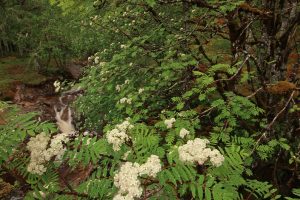
It has been a different experience to usual for me this spring, as I was away in southern South America for over 3 weeks from the middle of April onwards, where it was autumn in the forests. For the first time in many years therefore, I’ve missed out on some of my favourite phenomena in the Caledonian Forest – the return of the leaves on the trees, and the exuberance of the spring flowers, such as primroses and wood anemones, on the forest floor.
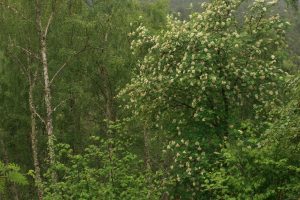
After my return, my available time for photography had been constrained by camera problems and family visits, so I relished the opportunity of having a day out in Glen Affric in early June. The forecast was for an overcast day with little or no wind, so it seemed an ideal day for taking photographs in the forest, where even lighting is much better than the contrast of sun and shadow, and a lack of movement from any breeze is necessary to get sharp images of plants and flowers etc.
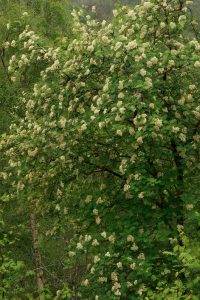
Driving up into the glen, just as I reached the cattle grid that marks the boundary of the National Nature Reserve (NNR), I saw a rowan tree (Sorbus aucuparia) in full flower close to the road. It was stunning in its vitality and abundant blossoms, and brought an instant smile to my face and a deep sense of appreciation in my heart.
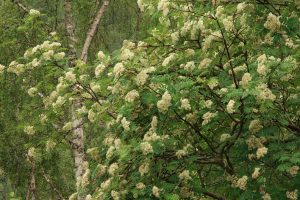
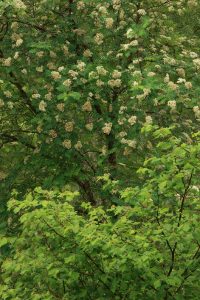
In front of the rowan, as I looked at it, was a young hazel (Corylus avellana), and its vigorous new growth seemed to be reaching up towards all the flowers …
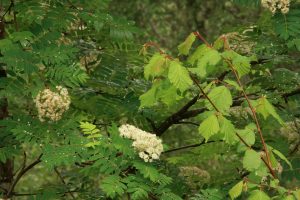
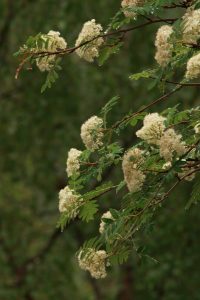
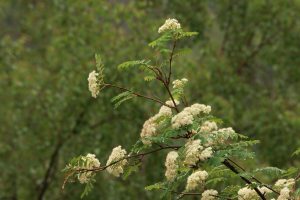
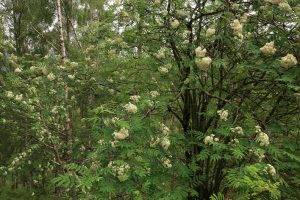
This rowan, through its profligate flowering and the unconstrained display of life force that it exhibited, seemed to provide me with a very fitting and joyous welcome to the glen. As it turned out, it also was to become a theme for my photography for the day. Nearby, and also beside the road, there were some other rowans, similarly in the fullness of bloom.
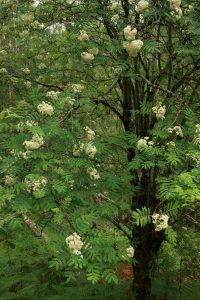
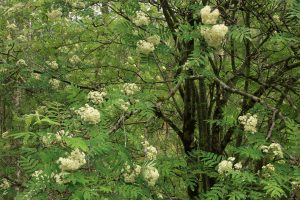
I’ve never spent so much time beside the road at the entrance to the NNR before, but it was impossible to resist the calling of these rowans in full floral flamboyance on the day!
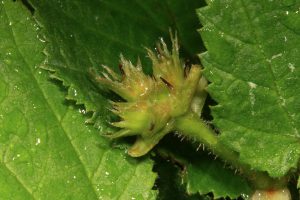
Driving a little further up the road, I stopped, as I often do, just above where the Affric River plunges over Badger Falls. One of my favourite oak trees (Quercus petraea) is situated right beside a bridge over a small burn there, and I frequently visit it when it’s in leaf, as there’s usually a lot of interest to see on it. Before I reached the oak though, my eye was drawn by a young hazel nearby and I spotted a shoot with three green tufty parts on the end of it. This was an early stage of the development of hazelnuts on the tree, and each of the tufts will, by the end of the summer, become a cup-shaped sheath of papery bracts, or modified leaves, that partially enclose the nut they surround.
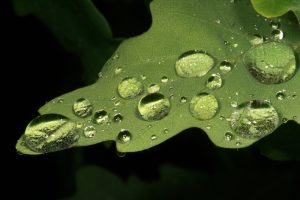
Reaching the oak itself I found there were water drops perfectly poised on many of the leaves, from rain that must have fallen a little earlier in the morning. On this windstill day they had remained there, each one acting like a miniature magnifying lens, expanding and revealing the cellular structure of the surface of the leaf it was on. The drops also caught the light, giving each leaf the appearance of being a natural chandelier, radiant with crystalline luminous beauty.
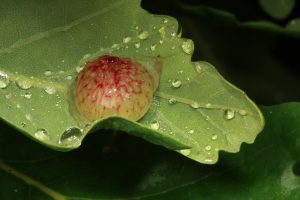
In amongst the raindrops on several of the leaves, and also on a number of the oak’s catkins, there were some reddish-green galls. These are called currant galls, and they are produced when the agamic, or non-sexual generation, of female wasps lay eggs on the newly emerging leaves and catkins in spring. The females are able to lay eggs without mating with a male, and the act of laying the eggs somehow induces the oak to produce these currant galls around each developing larva, providing both protection and a food source for the grub.
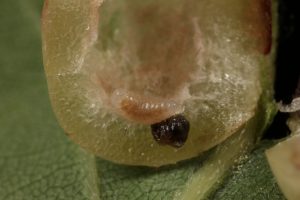
When the adult wasps emerge from the currant galls, the males and females mate, and the females lay eggs on the leaves of the oak, which then induce the tree to produce the disc-shaped spangle galls that sometimes occur in their dozens on each individual leaf. When the leaves fall to the forest floor in the autumn, the wasp larvae live on within them, overwintering there, and then a new agamic generation of females emerges in the spring, to begin the whole cycle again .
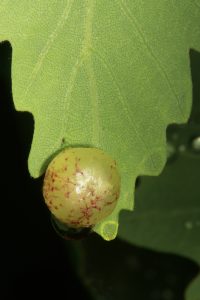
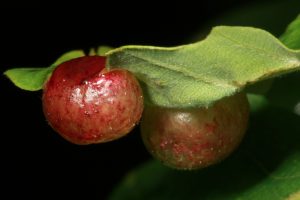
Two other closely-related wasps, the silk button spangle gall wasp (Neuroterus numismalis) and the smooth spangle gall wasp (Neuroterus albipes), also induce spangle galls on the leaves of oak during the summer.
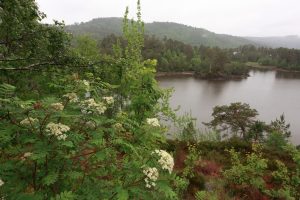
Leaving the oak behind, I drove further into the glen and stopped at a place where there’s an excellent view over the forest and Loch Beinn a’ Mheadhoin. There were more rowan blossoms visible here, and they were on quite a young tree that was less than two metres tall. It struck me as slightly unusual for such a small tree to be loaded with flowers, but it also confirmed the thought that I’d had already – that this is an excellent year for rowan flowers.
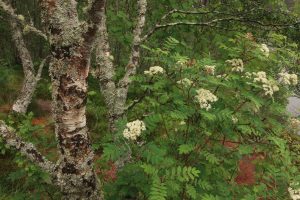
Like a number of other trees, such as oak, which produce seeds or nuts that are eaten by birds or mammals, the flowering of rowan trees varies considerably from year to year. Once every few years (which can vary from two or three to five or six), all the rowans flower and fruit in huge abundance, and this is known as ‘mast fruiting‘. 2016 is clearly one such year. This is then followed by several years with greatly reduced flowering, or sometimes almost none at all.
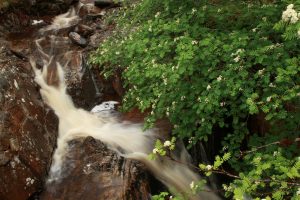
The theory that has been developed to explain this unusual and irregular cycle of mast fruiting (which occurs in tropical rainforests as well as temperate forests) is called the predator satiation theory. The rationale behind it is that in mast years the sheer volume of seed that is produced overwhelms the seed eaters (e.g. birds, small mammals etc), who cannot consume all that is produced, thereby ensuring that some seeds will survive to germinate and grow into a new generation of trees.
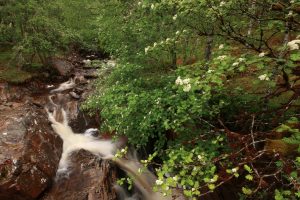
While the abundance of seed may allow the seed eaters to reproduce and increase in numbers in a mast year, the much lower availability of seed in the subsequent year(s) prevents them from sustaining this higher level of population that would enable them to eat all the seed produced in the next mast year. By varying its seed production in this dramatic way, the tree therefore creates the best opportunity for its lineage to continue with the successful growth of a new generation.
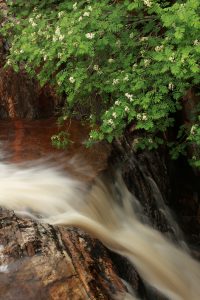
While this theory makes intuitive sense to me, the real mystery behind it is what triggers all of the trees, in this case the rowans, to synchronise their mass flowering in the same year. A number of possible explanations have been put forward for this, but the most likely cause is thought to be environmental factors, such as the temperature in the previous summer, when new buds for the following year are developing, and the amount of rainfall, which is a factor in determining how much new growth the trees can produce and sustain in a given year. Whatever the reason, the synchronous flowering of trees in both temperate forests and tropical ones is a significant event in these ecosystems, with knock-on benefits for the seed eaters, their predators and even the insects and other pollinators that harvest the trees’ nectar in exchange for providing the service of pollination. Interestingly enough, just after I returned from my trip to South America, I read a scientific paper about the Araucaria or monkey puzzle trees (Araucaria araucana) in Chile which I had been photographing there, and it confirmed that the predator satiation theory holds true for the mast fruiting of those trees.
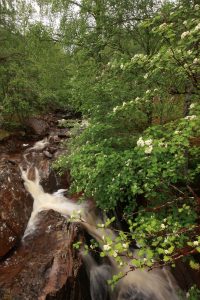
I don’t know if similar studies have been done for the rowan here in Scotland, but I was certainly enjoying the profligacy of the trees and the bounty of their blossoming this year.
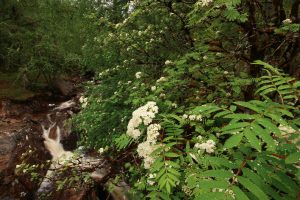
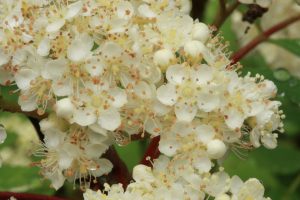
Each individual blossom in one of the clusters or corymbs is about 1 cm across, and the strong, sweet smell of the flowers attracts the flies, bees and beetles that pollinate the tree. Flowering does not last for long though, and when I returned to Glen Affric two weeks after these photographs were taken, very few blossoms were left on any of the rowans. Instead, young berries were already starting to form on them, and those will remain relatively inconspicuous until late summer, when they are fully grown and ripen to a bright red colour. Then the trees will be just as spectacular with dense clusters of their vividly-coloured fruits, and I’m looking forward to the opportunity of a second bumper season for rowan photography then.
Hi from sunny Cornwall! I’ve just found your blogs for the first time and am working my way through them. I’m hooked. I bought a field near my house and over the 2014-15 winter planted 2500 native saplings of about 15 species including rowan. Most are now taller than me and some (rowan) are flowering for the second time this year. Is this normal behaviour or is it likely to be related to the mild climate?
Hi Fiona,
Thanks for your comments about my blogs – I’m glad you’re enjoying them. I’ve not heard of rowans flowering twice in the same year, so it may be due to the milder climate in Cornwall. I’ve not observed that phenomenon in Scotland.
With best wishes,
Alan
Hi Alan, fascinating post as always.
Galls – what’s the evolutional theory behind these – do the trees gain from hosting the wasps through pollination etc?
Best, Matt.
Hi Matt,
Thanks for your comment – I’m glad you’re finding my blogs to be interesting. As far as I’m aware, the galling relationship is generally considered to be a parasitic one, i.e. the gall inducer benefits, but the host plant suffers (albeit in a minor way) through the diversion of its growth into a form that benefits the gall causer, but not the tree. In case of oak at least, it is pollinated by wind, not insects, so its myriad number of gall inducers (many of them wasps) provide no service in that regard.
With best wishes,
Alan
Thank you for explaining the mast fruiting and predator satiation theory. I learned a lot reading your blog. I also felt the sheer abundance of the rowan flowers in bloom in the forest this year. Even though I did not have the opportunity to visit the forest this year, I get a sense of connection to the forest by reading your blog. Thank you again for sharing the beauty and magic of the forest with your readers.
Many thanks for the positive feedback, Pupak!
With best wishes,
Alan
Wonderful article and photographs. I too look forward to your future post showing all the vivid coloured fruits but first let’s enjoy the many other spectacles that summer will bring.
Thanks for the feedback Ashley. Yes, there’s lots more to enjoy in the forest in the next couple of months before the rowan berries ripen!
With best wishes,
Alan